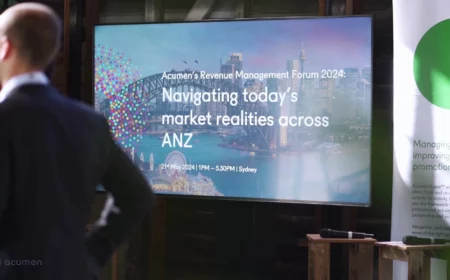The following article is a modified and summarised transcript from Acumen’s discussion with Kelly Rolader, Bic’s Head of RGM, on ‘Revenue management in 2023’. Some questions and answers have been condensed to better suit a written medium. If you would like to hear Kelly’s full answers, click below to watch the whole interview.
What shopper behaviour changes are you seeing because of the inflationary environment?
The inflationary environment has changed dramatically over the last few years, with 2022 being especially challenging globally. Shopper behaviour is varying greatly in different markets and categories for non-food products. There is a very different response from high inflationary markets such as Eastern Europe and Latin America when compared to North America or Western European Markets.
Either way, shoppers have become far more price sensitive and are turning to more affordable options. Having less discretionary income is forcing shoppers to look for value and brands they trust. Bic is high quality brand that shoppers trust, sitting squarely at ‘value for money’ positioning.
We have seen some positive response due to inflationary pressures that we’re facing, but how effective you are at this varies depending on market and position. If you are priced to meet shopper needs, you are winning. But if you haven’t figured out your price positioning and are not priced competitively, there a far more competitive threats that need to be negotiated and managed.
Are the challenges that you are experiencing different this year or are they a continuation of the themes you saw last year?
Bic has seen inflation accelerate over the last year. We manage pricing and have been tracking inflation regularly, as it has been rising steadily over 2022. As mentioned before, this has led to a change in shopper behaviour around the world.
Bic has had to react and look at RGM levers, pulling the right ones to keep shoppers engaged with the brand and to understand what they are experiencing and meet their needs. It’s about being consumer centric, understanding the shopper’s needs and meeting them so they have the right products on the shelf to purchase.
You mentioned some big differences geographically. Could you give a few examples of where it really does diverge for different regions?
As mentioned, between Eastern and Western European countries, most of the hyperinflation environments are in Eastern Europe. So due to price sensitivity, shoppers are moving towards less premium products. The situation is similar in Latin America as well. At Bic, we have a vast portfolio of products to meet shopper needs, from entry level to premium. It’s all about understanding the market, the consumers and the shoppers and creating a portfolio and packe price architecture to meet their needs.
When you’re trying to understand the needs of a particular region, such as eastern Europe, is there a one size fits all approach or are there different approaches that you use?
We research the demand of spaces and where there is the demand for our products etc. A fair amount of work is done on shopper willingness to pay to ensure that our products are priced right on the market end. Willingness to pay helps determine if we are priced right, helps the relationship and conversations with retailers and ensures that products are placed where their shoppers are looking for products on the shelf. In some cases, prices are where they need to be whilst in others there is room for a price increase, and, in certain cases, they may need to adjust pricing to make sure they are priced to meet the needs of the consumer.
How is price sensitivity affecting volume in Bic’s portfolio and how are you using RGM to counter volume drop?
From an RGM perspective, it is all about pulling the right levers to win. At Bic, RGM is defined using 5 levers: portfolio, product assortment and mix, pricing, promotion and partnering with customers. It’s about finding the right product in the right package at the right price and at the right channel.
Approaching it from customer need, have you had pushback from retailers on the approach Bic is taking this year?
Negotiations are more challenging, especially in Western retail where they are reluctant to take an increase on shelf price. There is a difference in food and non-food categories for retailers. They are more accepting of inflationary cost of goods increases in food rather than nonfood.
At Bic, the RGM function ensures that retailers and partners understand consumer willingness to pay and that a business case is presented to drive the right changes of price at shelf. This means educating the sales team so they have a strong understanding of their consumers and markets so, when negotiating with retailers, they can focus on creating a win-win situation. When capability is built, teams are able to talk to retailers about Bic, the value of the brand and the consumer willingness to pay.
Did you find that capability is something you had to actively dial up at BIC over the last couple years?
From a capability perspective, Bic’s RGM journey is relatively new as we have only been looking at it for 5 years. We want to make sure everyone in the company understands the RGM levers and the roles they play. It doesn’t matter what role you are in at Bic – everyone has a part to play to drive profitable growth. So we launched a large series of training and everyone from the CEO to a factory worker were required to take the training.
Are there any other areas where companies should focus on capability building?
There are a few important ones in 2023. The first one being pricing index management – not just price increases, but finding the right price. Consider PPA to make sure you have the right products in the right store at the right price. We use mixed management in the current environment as it ensures that we are selling the products to drive accretive sales for not only the manufacturer but the retailers as well.
The second is promotional effectiveness. It’s all about managing your trade dollars with retailers. Talk to your retail partners closely about price, because you need to ensure that you are priced right. Too often, suppliers give a deep discount which may not be necessary. It is important to understand the willingness to pay and which offer speaks to the shopper when they’re at that point of truth at the shelf and they’re deciding between our product and our competitor’s product.
The third one is complexity management, which other companies may call portfolio simplification. It’s a big focus for us with the supply chain challenges and everything that has occurred in the past few years. Bic has focused on simplifying its portfolio and narrowing assortments. Ensuring the right assortment and driving growth with the SKUs that are high net net sales SKU’s. That doesn’t mean you shouldn’t keep other SKU’s, but rather simplify choice for consumers at the shelf. Putting everything on a shelf creates confusion when you get into the heart of PPA and you need to understand what is needed on the shelf to drive sales.
Are there some key actors in other parts of the business that are pivotal to the conversations you’re having?
Marketing and supply chain are two of our closest partners on our journey. From a marketing perspective, it’s thinking about our portfolio, innovation and how to bring products to life with retailers so that shoppers are able to find them at the shelf. For supply chain, it’s managing cost of goods, ensuring a simplified portfolio and understanding how we can work with regions and leverage their expertise as well. Bic has automated factories where products are barely touched by humans. Due to this, working with supply chain partners to understand how RGM can be used to impact the cost of goods has been a key learning, because we have manufacturing operations throughout the world. The key thing when educating teams about RGM is to keep it simple.
We’d like to thank Kelly again for sharing her valuable insights. If you’d like to watch the conversation in full, you can do so here:



